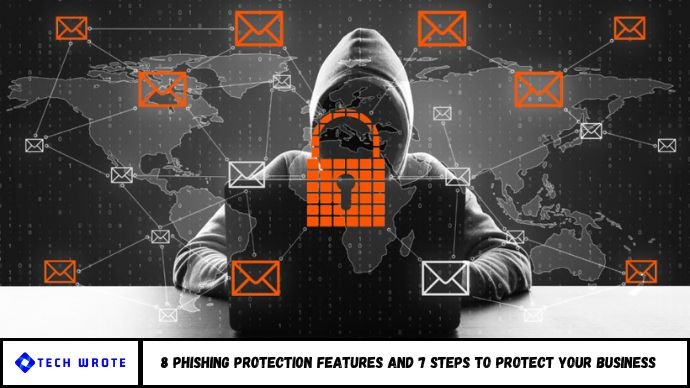Phishing protection is critical for modern businesses facing growing cyber threats. This article outlines eight essential phishing protection features every organization needs, and provides seven actionable steps to build a strong defense. Learn how to protect your business from data breaches, fraud, and reputation damage with effective tools and strategies.
Phishing protection involves a combination of technologies, policies, and security practices aimed at detecting, preventing, and responding to phishing attacks. These attacks typically trick users into revealing sensitive information—such as passwords or financial details—by posing as legitimate sources like trusted companies or colleagues.
The primary goal of phishing protection is to safeguard personal and corporate data from unauthorized access, helping prevent financial losses, identity theft, and large-scale data breaches.
Modern phishing protection strategies include:
- Advanced email filtering to detect malicious links and attachments
- Website authentication tools to block access to fraudulent sites
- AI-powered threat detection to identify evolving attack patterns
- Ongoing employee training to build security awareness and response
By combining proactive technology with user education, organisations can significantly lower their exposure to phishing threats and enhance overall cybersecurity resilience.
Introduction: Could a Fake Email Shut Down Your Business?
Imagine an employee clicks on a seemingly harmless email link—and suddenly, your entire business network is compromised. Phishing attacks are among the most common and successful forms of cybercrime, with over 90% of data breaches starting with a phishing email, according to Verizon’s 2024 Data Breach Report.
Despite increasing awareness, cybercriminals are getting smarter. They use psychological tactics, AI-generated messages, and authentic-looking pages to deceive users. But there’s good news: with the right features and protocols in place, your business can significantly reduce its risk.
This article explains the 8 most effective phishing protection features and the 7 strategic steps your business can implement right now to stay protected.
1. Why Phishing Protection Matters More Than Ever
Phishing isn’t just about spam—it’s about compromising credentials, stealing data, and disrupting operations. As businesses digitize processes, every user becomes a potential target.
Recent stats highlight the urgency:
- $4.91 million is the average cost of a phishing breach (IBM, 2024)
- 83% of companies reported phishing attempts in the past year (Proofpoint)
- Phishing is the most common ransomware entry point
Your business needs a multi-layered defense combining technology, training, and process.
2. 8 Essential Phishing Protection Features
1. Advanced Email Filtering
Detects and blocks suspicious emails before they reach inboxes using AI and machine learning to flag:
- Spoofed domains
- Malicious links and attachments
- Suspicious language patterns
2. Domain-Based Message Authentication (DMARC, SPF, DKIM)
These protocols verify the sender’s identity and prevent email spoofing, a common tactic in phishing.
3. Link Protection and URL Rewriting
Rewrites or inspects URLs in emails to detect and block access to malicious websites—even after delivery.
4. Attachment Sandboxing
Scans email attachments in a secure environment before allowing users to open them.
5. Threat Intelligence Integration
Real-time data from global threat feeds helps identify known phishing sources and block them automatically.
6. Multi-Factor Authentication (MFA)
Even if credentials are stolen, MFA adds a second layer of defense to prevent unauthorized access.
7. User Behavior Analytics
Monitors user activity and flags anomalies, such as unusual login locations or access patterns.
8. Security Awareness Training Tools
Simulated phishing tests and interactive training keep employees alert and informed.
3. 7 Steps to Protect Your Business from Phishing Attacks
Step 1: Educate and Train Your Team
Make employees your first line of defense with:
- Monthly phishing simulations
- Mandatory cybersecurity training
- Clear reporting procedures
Step 2: Deploy Robust Email Security
Choose a cloud-based email security platform with AI-powered threat detection and custom policy controls.
Step 3: Enforce Multi-Factor Authentication
Apply MFA to all user accounts, especially for administrators, remote workers, and financial systems.
Step 4: Monitor and Analyze Behavior
Use user behavior analytics to detect compromised accounts before damage occurs.
Step 5: Secure Your Domain
Implement DMARC, SPF, and DKIM to protect against email spoofing and impersonation.
Step 6: Create a Phishing Incident Response Plan
Have a documented process to:
- Isolate infected devices
- Revoke compromised credentials
- Notify internal teams and clients
- Conduct post-incident reviews
Step 7: Regularly Update Systems and Software
Patch vulnerabilities in email clients, browsers, and network infrastructure. Many phishing attacks exploit outdated software.
FAQs
1. What’s the most effective way to prevent phishing?
A combination of employee training, email filtering, and MFA provides the strongest protection.
2. How often should phishing training be conducted?
Ideally, conduct quarterly simulations and refresher courses at least twice a year.
3. Can small businesses afford phishing protection?
Yes. Many solutions offer scalable pricing and essential features at low cost.
4. What happens if a phishing attack succeeds?
Act fast—disconnect affected systems, change credentials, and notify your IT and compliance teams immediately.
5. Are phishing emails always obvious?
No. Many are sophisticated and tailored to look legitimate, especially spear phishing attempts.
6. Do antivirus programs stop phishing attacks?
Not always. Antivirus helps but should be part of a broader phishing protection strategy.
Conclusion
Phishing attacks aren’t going away. But with the right tools and strategies, your business doesn’t have to fall victim. Implementing 8 key protection features and following the 7 steps outlined above will greatly reduce your exposure to phishing threats.
Act now—before the next deceptive email lands in your inbox. The cost of prevention is far less than the cost of a breach.


